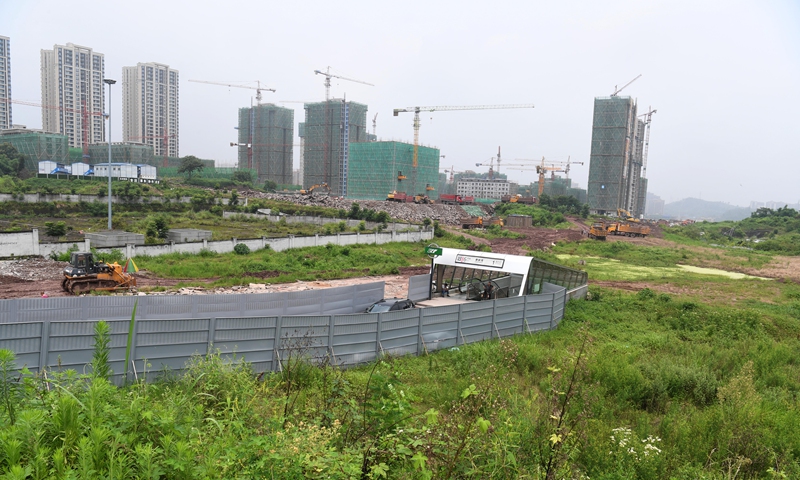China's 'ghost towns' come to life thanks to urbanization and policies
By Zhang Hui Source: Global Times Published: 2020/12/28 21:20:03
Urbanization, huge population, policies help destock properties: analysts

Caojiawan subway station in Southwest China's Chongqing Municipality in 2019. Photo: IC
High-rise apartment blocks, lakes, parks and long, straight roads but no people: These were typical post-apocalyptic Chinese "ghost towns" described by some Western media, but they could be the start of new cities and development miracles.
In a recent example, a subway station of Southwest China's Chongqing Municipality, which was mocked by CNN in 2017 as being built "in the middle of nowhere," and "with exits hidden among overgrown weeds," has made a fascinating turn.
The Caojiawan subway station shot to fame again recently after two online photos of the station to show how the facility started and how it is changing. An exit buried in overgrown weeds in one photo formed a sharp contrast with busy people and wide roads at the same exit.
The tweet by the netizen, Carl Zha, gained more than 23,000 likes as of press time, prompting some netizens to tweet other comparison photos of construction sites worldwide.
One netizen tweeted comparison photos of California's high-speed bullet train, showing passengers waiting to get on in one photo, and an abandoned bridge leading nowhere in the other.
Netizens reposted Zha's photos on Chinese social media, commenting that many of the "Chinese ghost towns" described by Western media have come to life.
Kangbashi district of Ordos in the Inner Mongolia Autonomous Region, which is another famous "ghost town" widely reported on by many major Western media outlets including the Wall Street Journal and CNN since 2012, has bid farewell to the nickname with its growing GDP, rising housing prices and long-term development plan.
Yang, a local resident of Kangbashi, told the Global Times on Monday that the district's average housing price rose by around 1,500 yuan ($230) per square meter this year to around 8,000 yuan, and more people from outside Ordos have settled in the city.
"Our place is not a ghost town anymore," Yang said.
The Kangbashi district, built on a vast wasteland in 2004, is now home to 150,000 permanent residents. Per capita GDP reached 173,000 yuan in 2019, compared with 70,800 yuan nationwide, the Economic Daily reported.
The city is exploring other means of economic growth, and Yang said he has seen many tourists visiting deserts and watching traditional performances involving Mongolian ethnicity in recent years.
In 2019, more than 2.8 million tourists visited Kangbashi, filling nearly all the hotel rooms, around 3,500 in the district, during the travel season, the Xinhua News Agency reported.
It is not just Kangbashi. Western media listed several Chinese towns or cities as ghost towns, claiming such developments were largely funded by ballooning debt, and "it's only a matter of time before it will burst."
Cong Yi, a professor at the Tianjin University of Finance and Economics, told the Global Times on Monday that there was a period in second- and third-tier cities when rapid construction accelerated the development of the population and public services, but in the long run, small and medium-sized cities will embrace a balance as overcrowded megacities will drive some people to these smaller cities.
"This process will digest the majority of the previously built buildings, although it will take time," Cong said.
China has a huge property destocking ability. Compared with Western countries such as the US, China is only at the middle stage of urbanization and has a huge population, Cong said, noting that the bubble is unlikely to burst.
But in the short term, some cities still face difficulty in destocking properties. Cities like Suzhou in East China's Jiangsu Province have offered preferential policies since last year to attract young talent, and it also came up with policies to encourage talents to buy properties three times in 2019.
Newspaper headline: China’s ‘ghost towns’ come to life
Posted in: SOCIETY